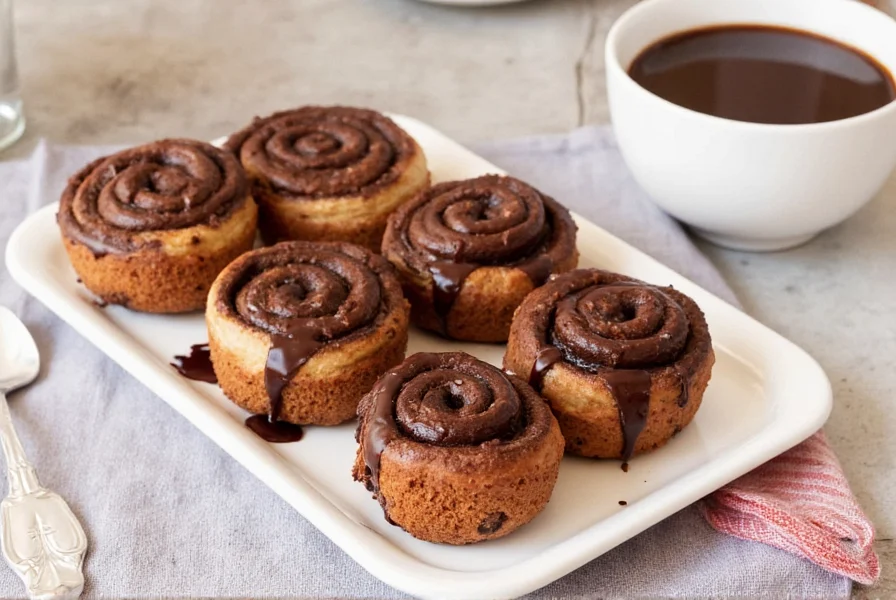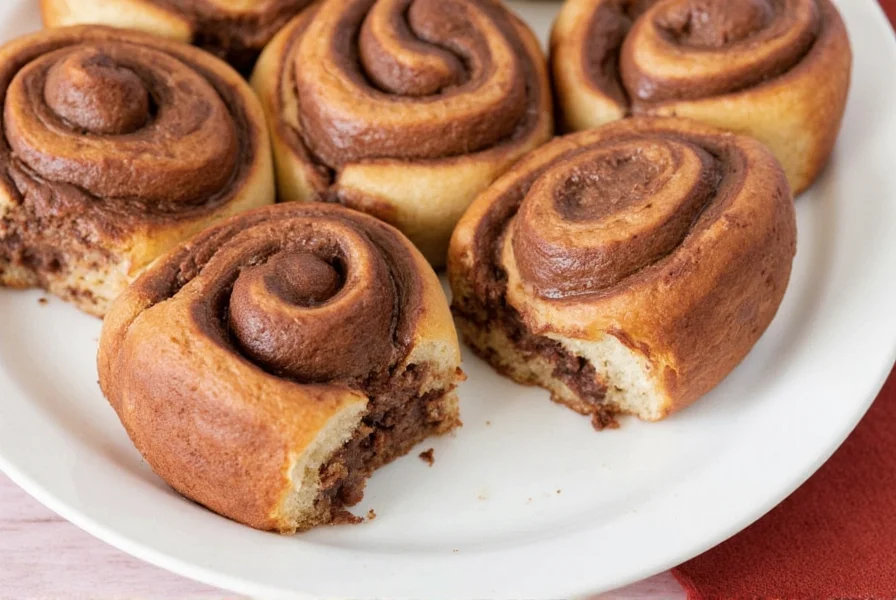Creating perfect chocolate cinnamon rolls requires understanding the delicate balance between chocolate intensity and the traditional cinnamon roll structure. Unlike standard versions, chocolate variations demand careful ingredient selection and technique adjustments to prevent dense texture or bitter aftertastes. The ideal chocolate cinnamon rolls feature a tender, airy yeast dough swirled with a chocolate-cinnamon filling, topped with a complementary chocolate or vanilla glaze that enhances rather than overwhelms.
The Essential Components of Perfect Chocolate Cinnamon Rolls
Successful chocolate cinnamon rolls depend on three critical elements: the enriched yeast dough, the chocolate-cinnamon filling, and the finishing glaze. Each component requires specific ingredients and techniques to achieve optimal results.
| Component | Key Ingredients | Critical Ratios |
|---|---|---|
| Dough | All-purpose flour, active dry yeast, warm milk, unsalted butter, egg, sugar, cocoa powder | 55-60% hydration (liquid to flour ratio), 5-8% cocoa powder by flour weight |
| Filling | Brown sugar, cinnamon, melted dark chocolate (60-70%), softened butter | 2:1 brown sugar to chocolate ratio, 1:1 butter to sugar ratio |
| Glaze | Powdered sugar, melted chocolate or cocoa, milk/cream, vanilla | 3:1 powdered sugar to liquid ratio, 15-20% chocolate content |
Mastering the Chocolate Cinnamon Roll Dough
The foundation of exceptional chocolate cinnamon rolls begins with properly formulated dough. Unlike regular cinnamon rolls, chocolate versions require strategic cocoa incorporation to maintain structure while delivering rich flavor. Natural cocoa powder works best for most home bakers, providing balanced acidity and flavor without the need for additional leavening adjustments required by Dutch-processed varieties.
When developing your homemade chocolate cinnamon rolls recipe, incorporate cocoa powder with dry ingredients rather than adding melted chocolate directly to the dough. Melted chocolate introduces excess fat and moisture that can compromise the delicate yeast dough structure. For optimal results, use 3-4 tablespoons of sifted cocoa per 3 cups of flour. This ratio delivers noticeable chocolate flavor without weighing down the rolls.
Creating the Perfect Chocolate-Cinnamon Filling
The filling represents where most chocolate cinnamon roll recipes fail. Many home bakers make the mistake of using chocolate chips in the filling, which don't melt properly during baking and create unpleasant pockets of unmelted chocolate. Instead, use finely chopped high-quality dark chocolate (60-70% cacao) melted with butter to create a smooth, spreadable filling.
Combine 4 ounces melted dark chocolate with 4 tablespoons softened butter, 1/2 cup packed brown sugar, and 1 1/2 teaspoons cinnamon. This ratio ensures the filling spreads evenly without leaking excessively during baking. The brown sugar's moisture content helps maintain the filling's pliability while contributing to caramelization during baking.
Proven Techniques for Flawless Chocolate Cinnamon Rolls
Achieving bakery-quality chocolate cinnamon rolls at home requires attention to specific techniques that address common failure points:
- Dough temperature control: Maintain dough temperature between 75-80°F (24-27°C) during first rise for optimal yeast activity without accelerating chocolate bloom
- Filling application: Spread filling to within 1/2 inch of dough edges to prevent leakage while ensuring even distribution
- Rolling technique: Roll dough tightly but gently to create defined swirls without compressing the dough
- Baking temperature: Start at 375°F (190°C) for 15 minutes, then reduce to 350°F (175°C) to finish baking without burning chocolate elements
Troubleshooting Common Chocolate Cinnamon Roll Problems
Even experienced bakers encounter issues with chocolate cinnamon rolls. Understanding these common problems and their solutions will dramatically improve your results:
- Dense texture: Usually caused by excessive cocoa powder or melted chocolate in dough. Stick to 5-8% cocoa by flour weight and avoid adding extra liquid ingredients.
- Leaking filling: Results from overfilling or improper rolling technique. Leave 1/2 inch border when spreading filling and seal edges well.
- Bitter aftertaste: Caused by low-quality chocolate or excessive cocoa. Use premium chocolate (60-70% cacao) and balance with adequate sugar.
- Collapsed rolls: Often happens when rolls are underbaked or removed from pan too soon. Allow 5 minutes resting in pan before transferring.
Storage and Reheating for Maximum Freshness
Chocolate cinnamon rolls maintain best quality when consumed within 24 hours. For optimal freshness, store unfrosted rolls in an airtight container at room temperature. Add glaze just before serving to prevent sogginess. To refresh day-old rolls, wrap individually in damp paper towels and microwave for 15-20 seconds.
For longer storage, freeze unfrosted rolls after the second rise. Place on parchment-lined baking sheets, freeze solid, then transfer to freezer bags. Bake from frozen, adding 5-7 minutes to baking time. This method preserves texture better than freezing baked rolls.

Delicious Variations to Try
Once you've mastered the basic chocolate cinnamon rolls recipe, experiment with these popular variations:
- Double chocolate: Add chocolate chips to the dough and use chocolate filling for intense flavor
- Chocolate-orange: Incorporate 1 tablespoon orange zest into dough and 1/4 cup orange juice into glaze
- Chocolate-hazelnut: Replace 1/4 of chocolate in filling with Nutella or hazelnut spread
- Spiced chocolate: Add 1/4 teaspoon each of cardamom and espresso powder to enhance chocolate flavor
Frequently Asked Questions
Can I use cocoa powder instead of melted chocolate in the filling?
Yes, but with adjustments. Mix 1/4 cup cocoa powder with 3 tablespoons melted butter and 1/2 cup brown sugar for a workable filling. However, melted chocolate creates a superior texture and richer flavor compared to cocoa-based fillings, which can become dry or chalky.
Why do my chocolate cinnamon rolls come out dense?
Dense chocolate cinnamon rolls typically result from excessive cocoa powder (more than 8% of flour weight), over-kneading the dough, or using melted chocolate directly in the dough instead of cocoa powder. The additional fat and moisture from melted chocolate disrupts the gluten structure. Stick to 3-4 tablespoons cocoa per 3 cups flour and avoid adding extra liquid ingredients.
How can I prevent my chocolate filling from leaking during baking?
To prevent leaking, spread the filling to within 1/2 inch of the dough edges, roll the dough tightly but gently, and ensure your filling has the right consistency—neither too runny nor too thick. Chilling the rolled log for 15 minutes before slicing helps maintain structure during baking. Using a bench scraper for clean cuts also minimizes filling displacement.
What's the best chocolate to use for chocolate cinnamon rolls?
For filling and glaze, use high-quality dark chocolate with 60-70% cacao content. This provides rich flavor without excessive bitterness. Avoid milk chocolate in fillings as its lower melting point causes excessive spreading. For dough, natural unsweetened cocoa powder works best—avoid Dutch-processed varieties unless adjusting leavening, as their neutral pH affects yeast activity.
Can I make chocolate cinnamon rolls ahead of time?
Yes, prepare the rolls through the second rise, then cover and refrigerate overnight. Remove from refrigerator 1-2 hours before baking to allow proper rising. Alternatively, freeze shaped rolls after the second rise, then bake from frozen with 5-7 extra minutes baking time. Never refrigerate or freeze after baking, as this compromises texture.











 浙公网安备
33010002000092号
浙公网安备
33010002000092号 浙B2-20120091-4
浙B2-20120091-4